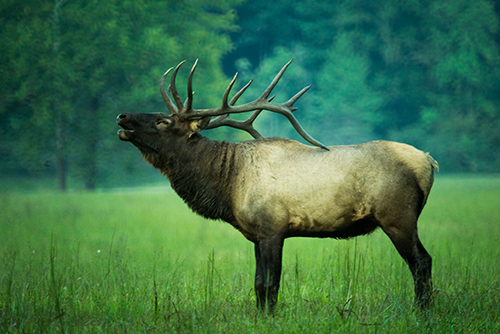Great Smoky Mountains National Park is among the most biodiverse landscapes managed by the National Park Service, with more than 19,000 documented species living within the park. But for almost two centuries, one of the park’s key mammals, the eastern elk, was missing from the mountains and valleys that flank the North Carolina-Tennessee state line.
The elk once gathered in large herds along the entire Appalachian Mountain range, from northern Georgia to southeastern Canada, but the species was eliminated from the region by the mid-1800s, due to overhunting and habitat destruction. A small number of elk were reintroduced to the park in 2001 as part of a trial to see if the animals could thrive again in the mountains of the south. Nearly 20 years later, that reintroduction has been successful, and the first-ever Smoky Mountain Elk Festival will celebrate the victory on September 13–14.
“We didn’t know if elk would make it in the Smokies,” says Kim DeLozier, former chief wildlife biologist with the park, who spearheaded the reintroduction in 2001. “It was an experiment. We put radio collars on them and let them do their thing. We didn’t know if they’d stay in the park. Would people kill them? Would they die from disease? Could they coexist with coyotes and bears?”
In 2001 the park introduced 25 elk to the Cataloochee Valley from Kentucky’s Land Between the Lakes National Recreation Area. Then, in 2002, they added another 27 elk from Elk Island National Park, in Alberta, Canada. Early in the reintroduction, black bears attacked some of the calves, but DeLozier says the elk cows got smarter and more defensive. Today, there’s a flourishing population that wildlife biologists estimate has grown to more than 150 animals.
But DeLozier, who now works as the eastern conservation program manager for the Rocky Mountain Elk Foundation, says the elk have spread throughout the park and into bordering lands, making it difficult for biologists to count the number of animals in the region. “We use 150 as a minimum, but there are probably many more than that,” he says.
Now the North Carolina Wildlife Commission is at the beginning of a five-year project to nail down an accurate figure. Not only have the elk increased in number over the last two decades, they’ve also grown in celebrity, becoming a major attraction for visitors to Great Smoky Mountains National Park.
“The elk are unique because most of the other wildlife in our region can be tough to find,” says Jennifer Gruhn, a naturalist and owner of Asheville Hiking Tours, which runs elk-viewing experiences in the park every fall. Gruhn explains that while other large animals like black bears, coyotes and bobcats tend to be elusive, elk are relatively easy to spot. “The elk will retreat to the woods during the middle of the day when it’s hot, but they show up in the Cataloochee Valley in the morning or evening, and you’ll see them come out to graze.”

Photo Courtesy: Cataloochee Convention and Visitors Bureau
The Smoky Mountain Elk Festival is timed to coincide with the mating season for elk, known as “the rut.” For three weeks during the fall, the elk put on a show, as the males, with fully developed racks, bugle and fight to get the attention of females, who gather in groups known as harems on the edge of fields.
“It’s something you don’t want to miss,” Gruhn says. “You’ll see groups of females paired with a single bull, who’s out in the field bugling continuously.”
Elk are massive animals, with males weighing up to 700 pounds, which makes them awe-inspiring to observe in the wild. But the sheer size and roaming nature of the animals has also led to conflicts, as they’ve moved beyond the borders of the national park into neighboring farms, sometimes damaging crops.
DeLozier says these conflicts are part of the growing pains of reintroducing a wild species to a landscape. The issues have also led the Rocky Mountain Elk Foundation to create the William H. Silvers Game Land, a 2,000-acre wildlife refuge adjacent to the park that provides the elk with space to roam. Part of the inspiration behind the new Smoky Mountain Elk Fest is to raise money for purchasing and improving wildlife habitat around the park. The fact that elk are moving beyond the borders of public lands is a sign that the species is thriving.
“A lot of people were skeptical about bringing elk back,” Delozier says. “By the turn of the 20th century, the wildlife situation in this area was dry compared to what we have today. Because man caused the demise of wildlife species, we have a responsibility to try to bring some of those animals back.”
Smoky Mountain Elk Fest, September 13–14, 2019
The festival is family friendly, and promises to be two days full of music, food, guided hikes and demonstrations. Tickets are $5 and proceeds help establish the Elk Conservation Fund.
